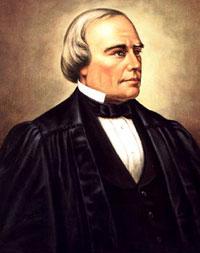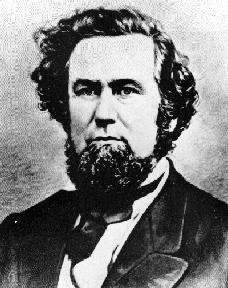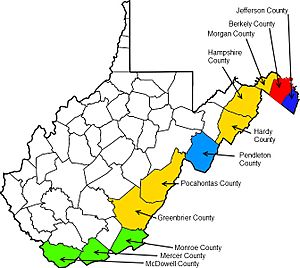Virginia v. West Virginia facts for kids
Quick facts for kids Virginia v. West Virginia |
|
|---|---|

|
|
| Decided March 6, 1871 | |
| Full case name | State of Virginia v. State of West Virginia |
| Citations | 78 U.S. 39 (more)
11 Wall. 39; 20 L. Ed. 67
|
| Holding | |
| Where a governor has discretion in the conduct of the election, the legislature is bound by his action and cannot undo the results based on fraud. | |
| Court membership | |
| Case opinions | |
| Majority | Miller, joined by Chase, Nelson, Swayne, Strong, Bradley |
| Dissent | Davis, joined by Clifford, Field |
Virginia v. West Virginia was an important case decided by the Supreme Court of the United States in 1871. The Court ruled that if a state's leader (the governor) has the power to manage an election, then the state's lawmakers (the legislature) must accept the results. They cannot change the results later by claiming there was cheating.
This case also confirmed that the counties that broke away from Virginia to form West Virginia had followed the rules. They had received permission from both the Commonwealth of Virginia and the United States Congress to become a new state. The Court also clearly stated that Berkeley County and Jefferson County were officially part of the new State of West Virginia.
Contents
How West Virginia Became a State
Virginia's Secession and the Civil War
When the American Civil War began in 1861, Virginia decided to leave the United States. This was mainly because of disagreements over slavery. However, many counties in northwestern Virginia wanted to stay with the Union.
Virginia's leaders voted to leave the U.S. on April 17, 1861. Even though voters still needed to approve this decision, Virginia's governor quickly joined forces with the Confederate States of America. By May 7, Virginia was formally part of the Confederacy. For U.S. President Abraham Lincoln, these actions showed that rebels had taken control of Virginia. He believed the state government was working against the United States.
The Reorganized Government of Virginia
People in northwestern Virginia strongly supported the Union. They started to organize their own government. A newspaper in Wheeling suggested a meeting to discuss separating from Virginia.
Delegates met in Wheeling in May 1861. They decided to wait to separate from Virginia until Virginia had officially left the U.S. To make sure their actions were fair, they planned new elections for June 4. On May 23, Virginians voted to approve secession.
New delegates were elected for a second meeting in Wheeling. These elections were a bit messy. Some happened under military pressure, and some counties didn't send anyone. On June 19, the Second Wheeling Convention declared that all government officials who supported secession had lost their jobs. They then formed a new government for Virginia from their own members.
The new leader, Governor Francis Harrison Pierpont, asked President Lincoln for military help. Lincoln recognized this new government as the true government of Virginia. This new government also sent new representatives to the U.S. Senate and U.S. House of Representatives. This meant Congress also recognized them.
Forming the State of West Virginia
The Second Wheeling Convention met again in August. They voted to allow 39 counties to separate from Virginia. They also said more counties, like Berkeley and Jefferson, could join if their voters agreed.
On October 24, 1861, voters in 39 counties, plus Hampshire and Hardy Counties, voted to leave Virginia. In some areas, very few people voted. A new meeting then wrote a constitution for the new state. They chose the name "West Virginia." They also debated which other counties should be included.
More counties were added, even some that hadn't voted. Berkeley, Frederick, Hampshire, Hardy, Jefferson, Morgan, and Pendleton Counties were again given the chance to join. All but Frederick County accepted. Some counties, like Greenbrier and Logan, never voted but were still included in the new state. West Virginia's new constitution was approved by voters on April 4, 1862.
Governor Pierpont then called the Reorganized Virginia legislature back together. On May 13, they approved the separation and agreed to include Berkeley, Frederick, and Jefferson Counties if they also approved West Virginia's constitution.
After much discussion, the U.S. Congress passed a law on July 14, 1862, allowing West Virginia to become a state. This law included a rule that all enslaved African Americans under 21 in the new state would be freed by July 4, 1863. President Lincoln had doubts about whether this was constitutional, but he signed the law on December 31, 1862.
Adding Berkeley and Jefferson Counties
West Virginia's constitution could be changed later if needed. On February 12, 1863, a meeting was held to discuss changes. They added the rule about freeing enslaved people, as Congress required. Voters in West Virginia approved this change on March 26, 1863. On April 20, Lincoln announced that West Virginia would become a state in 60 days.
Berkeley, Frederick, and Jefferson Counties were under Confederate control at this time. So, they never voted on joining West Virginia or its constitution. However, on January 31, 1863, the Reorganized Government of Virginia passed a law allowing elections in Berkeley County. A similar law was passed for Jefferson County on February 4, 1863. These elections were held, voters approved joining West Virginia, and Berkeley and Jefferson Counties became part of the new state.
However, on December 5, 1865, the Virginia Assembly in Richmond (the original Virginia government) passed a law. This law tried to cancel all the actions of the Reorganized Government that allowed counties to separate and Berkeley and Jefferson Counties to join West Virginia.
On March 10, 1866, Congress passed a resolution saying that the two counties had indeed moved from Virginia to West Virginia.
Virginia then sued, claiming that the elections in 1863 were unfair and that the original agreement for the counties to join West Virginia had not been followed. West Virginia argued that the Supreme Court didn't have the power to decide this case because it was a political matter.
The Supreme Court's Decision
The Majority Opinion
Justice Samuel Freeman Miller wrote the main decision for the Court. He was joined by Chief Justice Salmon P. Chase and other justices.
First, Justice Miller said the Court did have the power to hear the case. He pointed to several past cases where the Court had handled disputes between states.
Then, Justice Miller looked at three main questions:
- Did Virginia truly agree to let these counties become part of West Virginia?
- Did Congress also agree, making the deal valid?
- If both agreed, could Virginia later change its mind and get the counties back?
Justice Miller reviewed all the steps taken by the Reorganized Government of Virginia and the U.S. government to create West Virginia. He concluded that Virginia had clearly given its consent. Even though elections were delayed due to the war, the Reorganized Government had acted honestly.
Regarding Congress's agreement, Miller explained that Congress didn't need to approve every small detail. He noted that Congress had carefully discussed West Virginia's constitution, especially the part about slavery. This showed that Congress had thought deeply about the new state's boundaries. Miller said it was clear that Congress intended to agree to West Virginia becoming a state with its planned borders. This meant there was a valid agreement between the two states, approved by Congress.
Finally, Miller looked at Virginia's claim that the 1863 elections were unfair. He said that Virginia's complaints about cheating were "vague." No specific person was accused of fraud, and no clear wrongdoings were described. Virginia also didn't claim that West Virginia had interfered. Without strong evidence, Virginia's claims could not be accepted.
Miller also pointed out that the Reorganized Virginia legislature had given Governor Pierpont the power to certify the election results. Since he had certified them, Virginia was bound by his actions. Miller wrote that Virginia could not, years later, claim that its own actions were wrong or that its governor had been tricked.
The Dissenting Opinion
Justice David Davis wrote a different opinion, disagreeing with the majority. He was joined by two other justices.
Justice Davis believed that Congress had never truly agreed to the transfer of Berkeley and Jefferson Counties to West Virginia. He argued that by the time Congress did agree (in 1866), Virginia had already taken back its permission for the counties to join West Virginia.
Davis disagreed that Congress's debates about West Virginia's constitution meant they had agreed to the transfer of these two counties. He felt that Congress only agreed that the counties could be offered the chance to join. Since the conditions for joining weren't met by the time West Virginia became a state, no transfer could happen legally.
Why This Case Matters

When Virginia v. West Virginia first came to the Supreme Court, there were only eight justices. For three years, the Court was split 4-4 on whether it even had the power to hear the case. The Chief Justice waited until a majority of justices agreed that the Court could decide the matter. This decision to take the case is now seen as very important in the history of the Supreme Court's power.
It's interesting to note that Benjamin Robbins Curtis, a former Supreme Court Justice, argued the case for Virginia but did not win. He was famous for disagreeing with the Court's decision in the Dred Scott v. Sandford case.
Many people in Congress and legal experts have questioned whether the Reorganized Virginia government was truly legal and if West Virginia was created constitutionally. However, most experts now agree that the Reorganized government was legal. The Supreme Court had ruled in an earlier case, Luther v. Borden, that only the U.S. federal government could decide what kind of government a state should have. Since both the President and Congress recognized the Reorganized government, the process was considered legal.
There were also past examples of states being created in unusual ways. For example, Michigan and Kansas became states after elections that were not perfectly regular. One legal expert even called the process of West Virginia becoming a state "hyper-legal," meaning it followed the law very closely.
Even though the Supreme Court never directly ruled on whether West Virginia's creation was constitutional, decisions like Virginia v. West Virginia have made it clear that West Virginia is a legitimate state.
A different legal question comes from the U.S. Constitution itself. Article IV, Section 3, Clause 1 says:
States may be admitted by the Congress into this Union; but no new State shall be formed or erected within the Jurisdiction of any other State; nor any State be formed by the Junction of two or more States, or Parts of States, without the Consent of the Legislatures of the States concerned as well as of the Congress.
This part of the Constitution talks about how new states can be formed. It says a new state can't be made from parts of another state without the permission of the original state's legislature and Congress. If this rule meant no new state could ever be formed from an existing state, then states like Kentucky, Maine, and possibly Vermont would also have been created unconstitutionally.
Virginia v. West Virginia was also one of the first cases to show that Congress can give its approval in an "implied" way. This means Congress doesn't always have to say "yes" directly. Its approval can be understood from its actions and the situation. This idea has been used by the Court in many later cases.
Images for kids
-
Former Justice Benjamin Robbins Curtis argued the case for Virginia.






